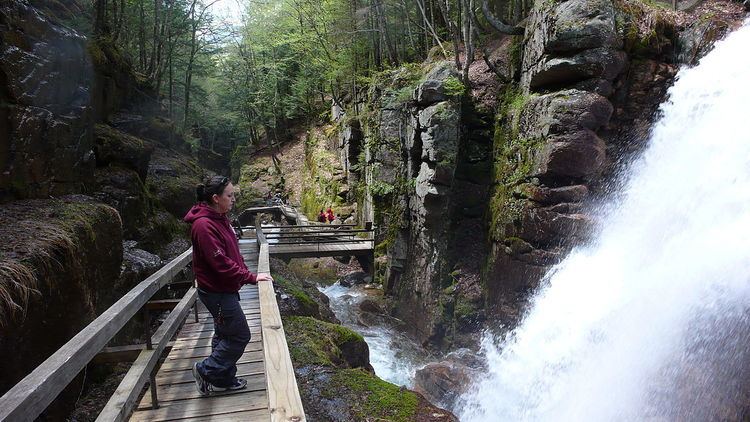Phone +1 603-745-8391 | ||
 | ||
Address 852 Daniel Webster Hwy, Lincoln, NH 03251, USA Hours Open today · 8:30AM–5PMMonday8:30AM–5PMTuesday8:30AM–5PMWednesday8:30AM–5PMThursday8:30AM–5PMFriday8:30AM–5PMSaturday8:30AM–5PMSunday8:30AM–5PM Similar Franconia Notch State Park, White Mountains, Cannon Mountain Ski Area, Cannon Mountain, Echo Lake | ||
Flume gorge
The Flume Gorge is a natural gorge extending 800 feet (240 m) horizontally at the base of Mount Liberty in Franconia Notch State Park, New Hampshire, United States. Cut by the Flume Brook, the gorge features walls of Conway granite that rise to a height of 70 to 90 feet (21 to 27 m) and are 12 to 20 feet (3.7 to 6.1 m) apart. Discovered in 1808 by 93-year-old "Aunt" Jess Guernsey, the Flume is now a paid attraction that allows visitors to walk through the gorge.
Contents
- Flume gorge
- Ultimate tour of the flume gorge new hampshire tourism lincoln nh
- Geological history
- Discovery
- Operating schedule
- References
Ultimate tour of the flume gorge new hampshire tourism lincoln nh
Geological history
Nearly 200 million years ago in the Jurassic period, the Conway granite that forms the walls of the Flume was deeply buried molten rock. As it cooled, the granite was broken by closely spaced vertical fractures which lay nearly parallel in a northeasterly direction. Sometime after the fractures were formed, small dikes of basalt were forced up along the fractures. The basalt came from deep within the earth as a fluid material, and because of pressure, was able to force the Conway granite aside. The basalt crystallized quickly against the relatively cold granite. Because of this quick cooling, the basalt is a fine- grained rock. Had this material ever reached the surface, it would have become lava flows.
Erosion gradually lowered the earth's surface and exposed the dikes. As the overlying rock was worn away, pressure was relieved and horizontal cracks developed, allowing water to get into the rock layers. The basalt dikes eroded faster than the surrounding Conway granite, creating a deepening valley where the gorge is now.
The gorge was covered by glaciers during the Ice Age, but the ice sheet did not greatly change the surface. It partially filled the valley with glacial debris and removed soil and weathered rock from the vicinity. After the Ice Age, Flume Brook began to flow through the valley again.
The highly fractured granite and basalt have been eroded by frost action as well as by the brook's water. As one walks through the Flume, at the floor of the gorge one may notice remnants of the main basalt dike, and that on the walls of the gorge, small trees are growing. Erosion is still occurring.
Discovery
The Flume was discovered in 1808 by 93-year-old “Aunt” Jess Guernsey when she accidentally came upon it while fishing. She had trouble convincing her family of the marvelous discovery, but eventually persuaded others to come and see for themselves. At that time, a huge egg-shaped boulder hung suspended between the walls. The rock was 10 feet (3.0 m) high and 12 feet (3.7 m) long. A heavy rainstorm in June 1883 started a landslide that swept the boulder from its place. That boulder fell down the gorge and destroyed a two-mile streak of forest. The boulder has never been found. The same storm deepened the gorge and formed Avalanche Falls.
Operating schedule
The Flume Gorge is open seasonally during the summer. Operating hours are 9:00 am to 5:00 pm. Dates and times are weather permitting. For up to date hours, please call the park directly.
